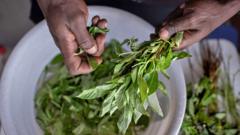The culinary landscape of Kenya is undergoing a renaissance, as indigenous leafy vegetables, once dismissed as "weeds" or food for the poor, reclaim their rightful place in both home kitchens and upscale restaurants. Known locally as "kienyeji," these traditional greens are now proudly featured on menus and sold at local markets, reflecting a significant shift in consumer attitudes.
At Skinners Restaurant in Gachie, just outside Nairobi, the growing demand for kienyeji greens has outstripped that for imported varieties. According to staff member Kimani Ng’ang’a, diners are willing to pay a premium for the locally sourced vegetables, which are often harder to procure than more common options like cabbage and spinach.
This change echoes a broader trend throughout Kenya, where consumers increasingly seek out organically grown vegetables that are rich in essential micronutrients. "It detoxifies the body and is good in weight loss," says James Wathiru, a patron who favors managu, or African nightshade. Many chefs and diners agree that the flavor of indigenous varieties far surpasses that of their introduced counterparts.
Mary Abukutsa-Onyango, a horticulture professor, reports that the production of native greens has doubled over the last decade, with 300,000 tonnes harvested last year. This trend is a remarkable turnaround from past attitudes, when traditional crops were often regarded as inferior to the imported varieties introduced during colonial rule.
Abukutsa-Onyango recalls the struggle to gain recognition for these indigenous vegetables in the 1980s when they were often labeled as “weeds.” Today, with support from the government and organizations focused on food security, there is a concerted effort to promote the benefits of crops like mrenda (jute mallow) and terere (amaranth), known for their superior nutritional profiles, including higher levels of vitamins A and C compared to common greens.
Recognition of these initiatives on a global stage was marked by UNESCO’s acknowledgment in 2021, praising Kenya for safeguarding its intangible cultural heritage which has been at risk of fading away. A national project initiated in 2007 has helped document an impressive 850 traditional foods, underscoring the value of biodiversity in agriculture.
While sukumawiki (spring greens) remains a dominant crop, with over 700,000 tonnes produced in 2023, farmers like Francis Ngiri are championing the cause of indigenous crops. Ngiri relocated his farming efforts to the Rift Valley, avoiding the chemical contamination that has plagued other regions. His focus on organic farming has allowed him to cultivate 124 native varieties, fostering collaboration among local farmers to preserve these "forgotten" plants.
Despite the growth in interest, legal obstacles limit farmers from freely exchanging seeds of indigenous crops, with a strict law prohibiting the sale of uncertified seeds. This has drawn criticism from agricultural advocates like Wambui Wakahiu and Dr. Peterson Wambugu, who highlight the need for reforms to enable the free exchange of seeds among farmers, aligning local laws with international treaties that honor farmers' rights.
As vegetable vendor Priscilla Njeri observes the increasing popularity of indigenous greens at the Wangige market, she attributes this momentum to media campaigns that celebrate their benefits. "Managu, terere, and kanzira are the most preferred – they simply taste better," she notes. This growing embrace of indigenous vegetables not only showcases the culinary diversity of Kenya but also points to a brighter future for sustainable agriculture and food security in the region.

















